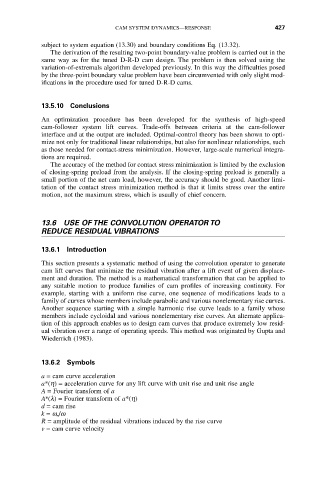Page 439 - Cam Design Handbook
P. 439
THB13 9/19/03 7:56 PM Page 427
CAM SYSTEM DYNAMICS—RESPONSE 427
subject to system equation (13.30) and boundary conditions Eq. (13.32).
The derivation of the resulting two-point boundary-value problem is carried out in the
same way as for the tuned D-R-D cam design. The problem is then solved using the
variation-of-extremals algorithm developed previously. In this way the difficulties posed
by the three-point boundary value problem have been circumvented with only slight mod-
ifications in the procedure used for tuned D-R-D cams.
13.5.10 Conclusions
An optimization procedure has been developed for the synthesis of high-speed
cam-follower system lift curves. Trade-offs between criteria at the cam-follower
interface and at the output are included. Optimal-control theory has been shown to opti-
mize not only for traditional linear relationships, but also for nonlinear relationships, such
as those needed for contact-stress minimization. However, large-scale numerical integra-
tions are required.
The accuracy of the method for contact stress minimization is limited by the exclusion
of closing-spring preload from the analysis. If the closing-spring preload is generally a
small portion of the net cam load, however, the accuracy should be good. Another limi-
tation of the contact stress minimization method is that it limits stress over the entire
motion, not the maximum stress, which is usually of chief concern.
13.6 USE OF THE CONVOLUTION OPERATOR TO
REDUCE RESIDUAL VIBRATIONS
13.6.1 Introduction
This section presents a systematic method of using the convolution operator to generate
cam lift curves that minimize the residual vibration after a lift event of given displace-
ment and duration. The method is a mathematical transformation that can be applied to
any suitable motion to produce families of cam profiles of increasing continuity. For
example, starting with a uniform rise curve, one sequence of modifications leads to a
family of curves whose members include parabolic and various nonelementary rise curves.
Another sequence starting with a simple harmonic rise curve leads to a family whose
members include cycloidal and various nonelementary rise curves. An alternate applica-
tion of this approach enables us to design cam curves that produce extremely low resid-
ual vibration over a range of operating speeds. This method was originated by Gupta and
Wiederrich (1983).
13.6.2 Symbols
a = cam curve acceleration
a*(h) = acceleration curve for any lift curve with unit rise and unit rise angle
A = Fourier transform of a
A*(l) = Fourier transform of a*(h)
d = cam rise
k = w n /w
R = amplitude of the residual vibrations induced by the rise curve
v = cam curve velocity

